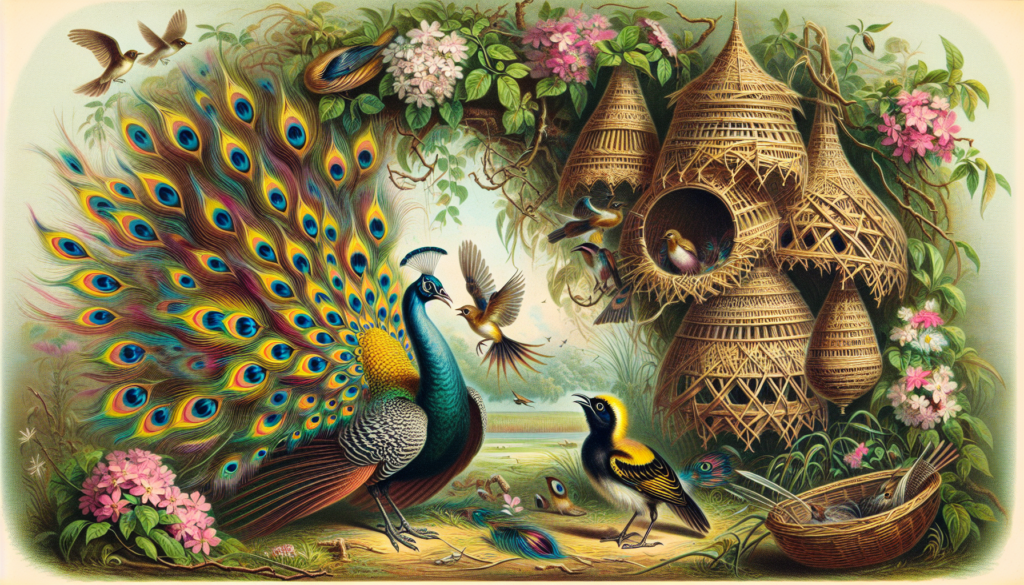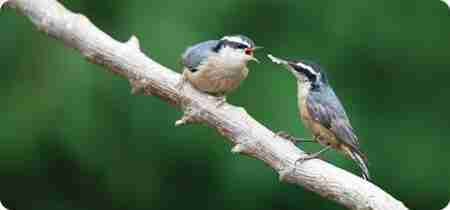Birds, with their vibrant colors and melodious songs, have long fascinated humans. Have you ever wondered how these enchanting creatures find their mates? Well, let’s take a closer look at the intricate world of bird courtship. From elaborate displays of feathers to mesmerizing duets, the mating habits of birds offer a fascinating glimpse into the wonders of nature. So, sit back and prepare to be captivated by the enchanting rituals that take place in the avian realm.
Courtship Behavior
Courtship behavior in birds is a fascinating display of attraction and communication between potential mates. Birds employ various strategies to capture the attention of their desired partner, including feather displays, singing and calling, as well as dances and rituals.
Feather Displays
Feather displays are one of the most visually striking courtship behaviors observed in birds. Male birds often have vibrant and elaborate plumage that they use to attract females. These feathers may be displayed in a variety of ways, such as fluffing up the feathers to create an impressive appearance or spreading their wings to showcase intricate patterns and colors. The intricate and colorful displays can signal the male bird’s health, fitness, and ability to provide for offspring.
Singing and Calling
Birds are well-known for their beautiful songs, which play a crucial role in courtship. Male birds sing melodious songs to establish territories, advertise their presence, and attract potential mates. Each species has its unique vocalization, which can range from simple melodic chirps to complex and elaborate compositions. The quality of a male’s song often reflects its genetic quality, indicating its suitability as a partner.
Dances and Rituals
Another captivating aspect of bird courtship involves intricate dances and rituals. These displays are particularly prominent in species like cranes and grouse. Male birds may perform elaborate courtship dances, involving intricate steps, wing-spreading, and head-bobbing movements. These rituals often serve to impress the female, demonstrating the male’s strength, agility, and overall fitness. The dances and rituals also act as a form of communication, conveying the male’s intentions and level of interest.
Choosing a Mate
When it comes to selecting a mate, birds employ a variety of criteria, including physical traits, vocalizations, and behavioral compatibility.
Physical Traits
Physical traits play a significant role in the mate selection process for many bird species. Males with vibrant and eye-catching plumage, such as the colorful plumage of male peacocks or the bright bills of puffins, are often preferred by females. These traits are indicative of good health, genetic fitness, and superior genes. Similarly, females may exhibit specific physical attributes that attract males, such as elaborate tail feathers or unique markings.
Vocalizations
Birds’ vocalizations are not only used for courtship but also play a crucial role in mate selection. Females often choose mates based on their vocal prowess. A male with a strong, melodious song may signal their overall health, vigor, and ability to provide for offspring. Some species engage in duets or call and response interactions, where males and females take turns vocalizing, strengthening their bond and confirming their compatibility.
Behavioral Compatibility
Behavioural compatibility is another crucial factor in mate selection for birds. Mates must be compatible in their behaviors and interactions to ensure successful breeding and offspring survival. Birds may engage in various behavioral displays during courtship, such as mutual preening, feeding each other, or engaging in synchronized flights. These behaviors allow the birds to assess their compatibility, level of cooperation, and willingness to invest in the breeding process.
Monogamy and Polygamy
Birds exhibit a range of mating strategies, including monogamy, polygamy, and serial monogamy. These mating systems offer different advantages and challenges for the species involved.
Monogamous Birds
Monogamy is a common mating strategy among birds, where a male and female form a pair bond and remain together for an extended period. This bonding often extends beyond a single breeding season and may last for several years or even for life. Monogamous birds work together to raise their offspring cooperatively, sharing the responsibilities of incubation, nest-building, and parental care.

Polygamous Birds
Polygamy is another common mating strategy observed in birds. Polygamous birds either practice polygyny, where a male mates with multiple females, or polyandry, where a female mates with multiple males. Polygynous species often have elaborate courtship displays and compete fiercely for access to mates. Polyandrous species, on the other hand, may engage in complex social arrangements, where multiple males share parental duties and compete to win the favor of a female.
Serial Monogamy
Some bird species engage in serial monogamy, where individuals form monogamous pairs for a breeding season or a specific period and then select new partners for subsequent breeding seasons. This mating strategy allows for increased genetic diversity and potential for successful offspring. Serial monogamy is commonly observed in bird species where resources are abundant, and competition for mates is less intense.
Nesting
Once a bird chooses its mate, the next step is to establish a suitable nesting site and begin the process of reproduction. Nesting involves various stages, including nest building, choosing a nest site, and laying the eggs.
Nest Building
Nest building is a remarkable behavior demonstrated by many bird species. Birds use a variety of materials, such as twigs, leaves, moss, feathers, and even manmade objects, to construct their nests. The structure and design of nests can vary significantly depending on the species. Some birds build intricate and well-organized nests, while others may construct simple platforms or burrows. The construction process often involves meticulous attention to detail, with each piece carefully placed to create a secure and comfortable environment for the eggs and future chicks.
Choosing a Nest Site
Selecting the right nest site is crucial for the success and survival of the offspring. Birds choose nesting sites that offer protection from predators, suitable microclimates, and ample food resources in the vicinity. Different species may have specific preferences for nesting locations, such as nesting in tree cavities, cliffs, or even in the ground. Some birds also exhibit site fidelity, returning to the same nesting site year after year.
Egg Laying
Once the nest is complete, the female bird begins the process of egg laying. The number of eggs laid varies among bird species, with some laying a single egg while others lay clutches of multiple eggs. The eggs are usually small and fragile, requiring careful incubation to ensure their survival. The female typically lays one egg per day until the clutch is complete, and then she starts the incubation process.

Incubation
Incubation plays a vital role in the development and hatching of bird eggs. This critical stage is responsible for maintaining the optimal temperature and humidity required for the embryo’s growth and development. Depending on the species and mating system, incubation can be a shared activity between both parents or predominantly performed by either the male or female.
Shared Incubation
In some bird species, both the male and female share the responsibility of incubation. They take turns sitting on the eggs, ensuring a consistent temperature and protecting the developing embryos. This shared incubation process strengthens the bond between parents and allows both individuals to engage in other essential activities, such as foraging or defending the nest.
Male Incubation
In certain bird species, such as the emu or ostrich, the male takes primary responsibility for incubating the eggs. The females lay the eggs and then leave them in the care of the male. The male diligently tends to the eggs, providing warmth and protection until they hatch. This reversal of traditional gender roles in incubation is an intriguing adaptation seen in these species.
Female Incubation
In many bird species, the female is primarily responsible for incubating the eggs. The female bird spends extended periods of time sitting on the nest, carefully maintaining the ideal conditions for the developing embryos. During this incubation period, the male often assumes the role of providing food and protection for the female. This division of labor ensures the successful development of the eggs and the survival of the chicks once they hatch.
Parental Care
Parental care in birds is crucial for the survival and well-being of their offspring. Once the eggs hatch, the parents must provide consistent food, protection, and guidance to ensure the chicks’ growth and development.
Feeding the Chicks
Feeding the chicks is an essential aspect of parental care. Depending on the species and the availability of food resources, both parents may take turns locating and bringing food to the nest. Some birds regurgitate food for their chicks, while others provide freshly caught prey. As the chicks grow, their nutritional needs change, and parents must adapt their feeding strategies accordingly.
Protecting the Nest
Protecting the nest from predators is another critical responsibility of bird parents. They employ various defensive behaviors to thwart potential threats, such as warning calls, dive bombing, or aggressive displays. Some bird species even engage in cooperative defense, where multiple individuals join forces to protect their offspring from harm. Nests may also be strategically placed in locations that offer natural protection, such as high in trees or hidden amidst dense vegetation.
Teaching Survival Skills
Parent birds play an essential role in teaching their offspring vital survival skills. They demonstrate foraging techniques, flight proficiency, and social interactions necessary for future success. The parents communicate through calls, behavior modeling, and guiding the chicks as they explore their surroundings. This guidance and nurturing contribute to the chicks’ development and prepares them for independence once they fledge.
Mating Systems and Strategies
Birds employ various mating systems and strategies to maximize breeding success and pass on their genetic material. These strategies include lekking, extra-pair copulations, and promiscuity.
Lekking
Lekking is a mating strategy observed in certain bird species, where males gather in specific sites (lek) to perform elaborate displays and courtship rituals. Females visit the lek to choose their mates, often selecting the male with the most impressive display. The males, however, do not provide any parental care after mating, and the responsibility of raising the offspring falls solely on the female.
Extra-pair Copulations
Extra-pair copulations involve individuals mating outside of their established pair bond or social group. This behavior is more commonly observed in species where there is high mate competition or limited resources. These copulations can lead to increased genetic diversity within a population but may also result in conflict and competition between individuals.
Promiscuity
Promiscuity refers to a mating system where individuals engage in multiple sexual partners without forming long-term pair bonds. In promiscuous species, both males and females may mate with multiple partners within a short period. This behavior can increase the chances of successful reproduction and genetic diversity within the population but may also result in intense competition and conflict between individuals.





Breeding Seasons
Birds exhibit different breeding season patterns, with some species breeding seasonally, all year round, or irregularly.
Seasonal Breeding
Many bird species have a specific breeding season tied to environmental cues, such as temperature, daylight hours, or food availability. These species mate and raise their offspring during a particular time of the year, ensuring that the offspring have the best chances of survival. Seasonal breeding often synchronizes with the availability of food resources, maximizing the chances of successful breeding and chick survival.
Year-round Breeding
Some bird species do not have a particular breeding season and can reproduce year-round. These birds may take advantage of stable and abundant food resources available throughout the year. Year-round breeding provides greater flexibility and the opportunity for multiple reproductive cycles within a single year. This continuous breeding pattern allows for increased reproductive output, but also poses challenges such as constant parental care and breeding competition.
Irregular Breeding
Certain bird species exhibit irregular breeding patterns that are not tied to a specific season or time of the year. These irregular breeding behaviors may be influenced by factors such as unpredictable food availability or fluctuations in population density. The timing and frequency of breeding in these species can vary greatly, depending on external conditions and individual circumstances.
Mating Rituals of Specific Bird Species
Different bird species demonstrate unique and captivating mating rituals that reflect their evolutionary history and ecological niche. Some notable examples include the Peacock, Albatross, and Bowerbirds.
Peacock
The male peacock is renowned for its elaborate courtship display. During courtship, the male fans out its long, iridescent tail feathers, forming a striking visual display known as a “train.” The male then vibrates its feathers while simultaneously emitting low-frequency calls to attract females. The peacock’s elaborate plumage and dance-like movements are a testament to the power of sexual selection within the species.
Albatross
Albatrosses have intricate courtship rituals that involve synchronized dances and displays of their wide wingspans. These dances serve as a means of pair bonding and reinforcing the bond between mates. Albatrosses are known for their long-term monogamy, and their courtship displays play a crucial role in strengthening their lifelong partnerships.
Bowerbirds
Bowerbirds are renowned for their remarkable breeding behavior, specifically their extravagant bower building. Male bowerbirds construct intricate structures (bowers) made from twigs, leaves, and other materials, often adorned with vibrant objects like flowers or colorful feathers. These bowers serve as stages for elaborate courtship displays, where males perform intricate dances and vocalizations to attract females. The complexity and creativity of the bowers vary among species, showcasing the male’s dedication and ability to provide a suitable environment for mating.
Human Impact on Bird Mating Habits
Human activities have a significant impact on bird mating habits, leading to both positive and negative consequences for bird populations worldwide.
Habitat Loss
Habitat loss, primarily due to deforestation, urbanization, and agriculture, disrupts the natural breeding and nesting habitats of many bird species. Destruction of nesting areas and diminished access to food resources can limit breeding opportunities and hinder successful reproduction. It is crucial for conservation efforts to focus on habitat restoration and protection to maintain healthy bird populations and preserve their mating behaviors.
Climate Change
Climate change presents a significant threat to bird mating habits. Altered temperature patterns, shifts in precipitation, and changing migration patterns can disrupt breeding seasons and impact the availability of food resources. Birds may face challenges in synchronizing mating behaviors with optimal environmental conditions, leading to reduced reproductive success and population declines. It is paramount to address climate change through sustainable practices and conservation efforts to mitigate its impact on bird mating patterns.
Nest Destruction
Human interference can often lead to the destruction or disturbance of bird nests. Activities such as tree trimming, building renovations, and agricultural practices can inadvertently damage or destroy nests, leading to the loss of eggs or chicks. It is essential for individuals and communities to be aware of nesting areas and implement measures to protect and preserve these critical breeding sites.
Conclusion
In conclusion, bird mating habits are an intricate and diverse aspect of avian biology. From elaborate courtship displays to shared parental care, birds employ a range of strategies to ensure reproductive success. Understanding and appreciating these mating behaviors not only provides insights into avian ecology but also highlights the importance of preserving habitats and minimizing human impact to safeguard the future of bird populations worldwide.



